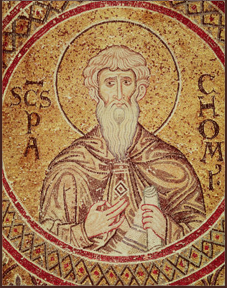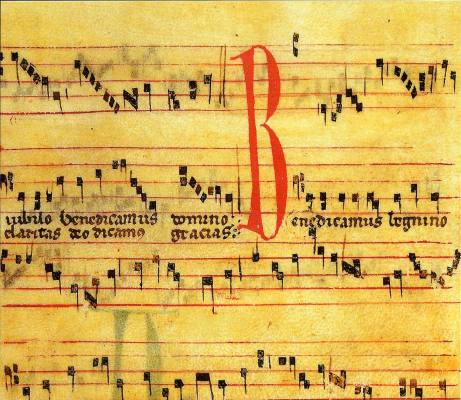 |
| from Limburg Cathedral |
It is 17 March, and normally St. Patrick gets all the attention today, but he is not the only saint whose feast day is celebrated on this date (although, arguably, his feast day is celebrated more heartily than any other saint).
Take a close look at the lower-left corner of the stained glass window pictured here. You will see a rodent gazing up at the saint, who gazes gently down at it. This is Saint Gertrude, patron of travelers and cat lovers.
Gertrude of Nivelles was born c. 626 to Pippin/Pepin of Landen, a 7th century Mayor of the Palace under Dagobert I (previously mentioned
here and
here). As daughter of a Mayor of the Palace (who was himself very powerful and not just a chamberlain to the king), she would have had some status—at least, as a link to the family. The story goes that King Dagobert wanted to make a political alliance by marrying her to the son of the Duke of Austrasia. She refused, claiming she would take no earthly spouse, but rather Christ the Lord. That she was able to refuse the king's wishes attests to the power of her family.*
After Pippin's death, his wife, Itta, took control of Gertrude's life and career. The biography written about her—
Vita Sanctae Geretrudis—tells that her mother tonsured her, cutting off all her hair except for a crown shape, in order to mark her for the religious life and prevent the prospect of marriage. A close examination of the
Vita suggests that it as written by someone who was contemporary with Gertrude, and may have witnessed some of the events involved first-hand.
Itta founded an abbey in Nivelles, in the center of what is now Belgium. Itta also contacted Irish monks led by Saint Foillan, who settled at Nivelles. Foillan seems to have been a bishop, whose status helped give authority to the founding and organizing of Nivelles.
Gertrude has miracles attributed to her. The first was when she observed a transparent flaming globe descend and float above her while praying in the basilica. The second is when the invocation of her name by some men sailing on the monastery's business causes a storm and a sea monster both to fade away. This makes her the patron saint of travelers. She and her mother supposedly kept cats in order to control the rodent population in the monastery, which makes her the patron saint of cats and cat lovers; or, at least, the patron saint
against mice.
She fasted and deprived herself frequently, which took a toll on her body. She died on 17 March 659, aged only (but symbolically) 33 years. The author of the
Vita claims her cell was filled with a pleasant odor at her death; this is the "Odor of Sanctity" associated with saints.
*
I have written before of the power of the Mayors of the Palace and their eventual supplanting of the Merovingian kings, creating the Carolingian dynasty. At least one scholar believes that Gertrude's marriage to an eventual Austrasian Duke would have been advantageous for her family and led to a takeover from the Merovingian line even sooner. (Wemple, Suzanne Fonay. Women in Frankish Society: Marriage and the Cloister, 500-900.)



















